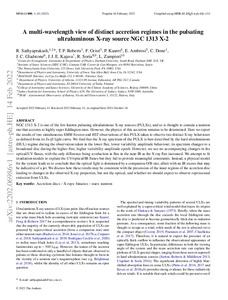A multi-wavelength view of distinct accretion regimes in the pulsating ultraluminous X-ray source NGC 1313 X-2
Zampieri Luca; Gladstone Jeanette C.; Grisè Fabien; Sathyaprakash Rajath; Roberts Timothy P.; Kaaret Philip; Done Christine; Ambrosi Elena; Soria Roberto; Kajava Jari J. E.
A multi-wavelength view of distinct accretion regimes in the pulsating ultraluminous X-ray source NGC 1313 X-2
Zampieri Luca
Gladstone Jeanette C.
Grisè Fabien
Sathyaprakash Rajath
Roberts Timothy P.
Kaaret Philip
Done Christine
Ambrosi Elena
Soria Roberto
Kajava Jari J. E.
OXFORD UNIV PRESS
Julkaisun pysyvä osoite on:
https://urn.fi/URN:NBN:fi-fe2022081154318
https://urn.fi/URN:NBN:fi-fe2022081154318
Tiivistelmä
NGC 1313 X-2 is one of the few known pulsating ultraluminous X-ray sources (PULXs), and so is thought to contain a neutron star that accretes at highly super-Eddington rates. However, the physics of this accretion remains to be determined. Here, we report the results of two simultaneous XMM-Newton and HST observations of this PULX taken to observe two distinct X-ray behaviours as defined from its Swift light curve. We find that the X-ray spectrum of the PULX is best described by the hard ultraluminous regime during the observation taken in the lower flux, lower variability amplitude behaviour; its spectrum changes to a broadened disc during the higher flux, higher variability amplitude epoch. However, we see no accompanying changes in the optical/UV fluxes, with the only difference being a reduction in flux in the near-infrared (NIR) as the X-ray flux increased. We attempt to fit irradiation models to explain the UV/optical/IR fluxes but they fail to provide meaningful constraints. Instead, a physical model for the system leads us to conclude that the optical light is dominated by a companion O/B star, albeit with an IR excess that may be indicative of a jet. We discuss how these results may be consistent with the precession of the inner regions of the accretion disc leading to changes in the observed X-ray properties, but not the optical, and whether we should expect to observe reprocessed emission from ULXs.
Kokoelmat
- Rinnakkaistallenteet [19207]
